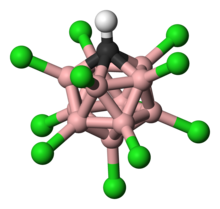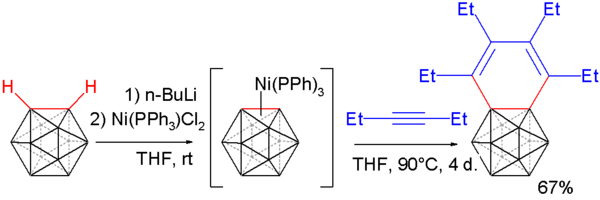Carborà


Un carborà, en anglès: carborane és un compost clúster químic compost per àtoms de bor, carboni i hidrogen. Són polièdrics.
Són exemples interessants de carborans aquells que són icosahèdrics extremadament estables. Aquests clústers rics en bor mostren propietats organomimètiques úniques amb molècules orgàniques metàl·liques
Un exemple de carborà de càrrega neutra és el C₂B10H₁₂ o o-carborà que té molts usos en polímers resistents a la calor i en medicina L’àcid carborà, és un superàcid amb clor, H(CHB11Cl11).
Dicarbadodecaborà

El carborà més estudiat és C₂B10H₁₂, m. p. 320 °C. Sovint es prepara per a la reacció amb acetilè amb decaborà. A
Història
Els 1,2-closo-dicarbadodecaborans (normalment simplement dits carborans), van ser descoberts de forma simultània per grups d'Olin Corporation i la Reaction Motors Division of Thiokol Chemical Corporation treballant junts per a la U.S. Air Force and published in 1963. Aquest grups van demostrar l'estabilitat sense precedents dels 1,2-closo-dodecaboran grup.
Carborins
Caborin, Carboryne, o 1,2-dehydro-o-carboran, és un derivat inestable de l’ortocarboran amb la fórmula B10C₂H10. Un compost carborin es va generar primer l’any 1990 a partir de l’o-carboran. posteriorment, el resultant dianió del liti reacciona amb brom a 0 °C per formar el monoanió del brom.
Els carborins reaccionen amb alquins per formar benzocarborans
Recerca
Els carborans han estat explorats com una font de bor en la teràpia de captura de neutrons de bor. També per estudis de cristal·lografia.
Els carborans han estat usats per a fer superàcids sòlids que tenen un avantatge mediambiental sobre els àcids dissolts. El superàcid carboran H(CHB11Cl11) té una constatnt de dissociació un milió de vegades més alta que la de l'àcid sulfúric.
Referències
- ↑ Jemmis, E. D. «Overlap control and stability of polyhedral molecules. Closo-Carboranes». Journal of the American Chemical Society, 104, 25, 1982, pàg. 7017–7020. DOI: 10.1021/ja00389a021.
- ↑ Spokoyny, A. M. «New ligand platforms featuring boron-rich clusters as organomimetic substituents». Pure and Applied Chemistry, 85, 5, 2013, pàg. 903–919. DOI: 10.1351/PAC-CON-13-01-13.
- ↑ Kutal, C. R.; Owen, D. A.; Todd, L. J. «Closo-1,2-dicarbadodecaborane(12)». Inorganic Syntheses, 11, 1968, pàg. 19–23. DOI: 10.1002/9780470132425.ch5.
- ↑ Heying, T. L.; Ager, J. W.; Clark, S. L.; Mangold, D. J.; Goldstein, H. L.; Hillman, M.; Polak, R. J.; Szymanski, J. W. «A New Series of Organoboranes. I. Carboranes from the Reaction of Decaborane with Acetylenic Compounds». Inorganic Chemistry, 2, 6, 1963, pàg. 1089–1092. DOI: 10.1021/ic50010a002.Schroeder, H.; Heying, T. L.; Reiner, J. R. «A New Series of Organoboranes. II. The Chlorination of 1,2-Dicarbaclosododecaborane(12)». Inorganic Chemistry, 2, 6, 1963, pàg. 1092–1096. DOI: 10.1021/ic50010a003.Heying, T. L.; Ager, J. W.; Clark, S. L.; Alexander, R. P.; Papetti, S.; Reid, J. A.; Trotz, S. I. «A New Series of Organoboranes. III. Some Reactions of 1,2-Dicarbaclosododecaborane(12) and its Derivatives». Inorganic Chemistry, 2, 6, 1963, pàg. 1097–1105. DOI: 10.1021/ic50010a004.Papetti, S.; Heying, T. L. «A New Series of Organoboranes. IV. The Participation of the 1,2-Dicarbaclosododecaborane(12) Nucleus in Some Novel Heteratomic Ring Systems». Inorganic Chemistry, 2, 6, 1963, pàg. 1105–1107. DOI: 10.1021/ic50010a005.Fein, M. M.; Bobinski, J.; Mayes, N.; Schwartz, N.; Cohen, M. S. «Carboranes. I. The Preparation and Chemistry of 1-Isopropenylcarborane and its Derivatives (a New Family of Stable Closoboranes)». Inorganic Chemistry, 2, 6, 1963, pàg. 1111–1115. DOI: 10.1021/ic50010a007.Fein, M. M.; Grafstein, D.; Paustian, J. E.; Bobinski, J.; Lichstein, B. M.; Mayes, N.; Schwartz, N. N.; Cohen, M. S. «Carboranes. II. The Preparation of 1- and 1,2-Substituted Carboranes». Inorganic Chemistry, 2, 6, 1963, pàg. 1115–1119. DOI: 10.1021/ic50010a008.Grafstein, D.; Bobinski, J.; Dvorak, J.; Smith, H.; Schwartz, N.; Cohen, M. S.; Fein, M. M. «Carboranes. III. Reactions of the Carboranes». Inorganic Chemistry, 2, 6, 1963, pàg. 1120–1125. DOI: 10.1021/ic50010a009.Grafstein, D.; Bobinski, J.; Dvorak, J.; Paustian, J. E.; Smith, H. F.; Karlan, S.; Vogel, C.; Fein, M. M. «Carboranes. IV. Chemistry of Bis-(1-carboranylalkyl) Ethers». Inorganic Chemistry, 2, 6, 1963, pàg. 1125–1128. DOI: 10.1021/ic50010a010.Grafstein, D.; Dvorak, J. «Neocarboranes, a New Family of Stable Organoboranes Isomeric with the Carboranes». Inorganic Chemistry, 2, 6, 1963, pàg. 1128–1133. DOI: 10.1021/ic50010a011.
- ↑ Gingrich, H. L.; Ghosh, T.; Huang, Q.; Jones, M. «1,2-Dehydro-o-carborane». Journal of the American Chemical Society, 112, 10, 1990, pàg. 4082–4083. DOI: 10.1021/ja00166a080.
- ↑ Jemmis, E. D.; Kiran, B. «Structure and Bonding in B10X₂H10 (X = C and Si). The Kinky Surface of 1,2-Dehydro-o-Disilaborane». Journal of the American Chemical Society, 119, 19, 1997, pàg. 4076–4077. DOI: 10.1021/ja964385q.
- ↑ Kiran, B.; Anoop, A.; Jemmis, E. D. «Control of Stability through Overlap Matching: closo-Carboranes and closo-Silaboranes». Journal of the American Chemical Society, 124, 16, 2002, pàg. 4402–4407. DOI: 10.1021/ja016843n.
- ↑ Deng, L.; Chan, H.-S.; Xie, Z. «Nickel-Mediated Regioselective Cycloaddition of Carboryne with Alkynes». Journal of the American Chemical Society, 128, 24, 2006, pàg. 7728–7729. DOI: 10.1021/ja061605j. PMID: 16771473.
- ↑ Jemmis, E. D.; Anoop, A. «Theoretical Study of the Insertion Reactions of Benzyne- and Carboryne- Ni Complexes» (pdf). Maui High Performance Computing Center Application Briefs. Air Force Maui Optical & Supercomputing Site (AMOS), 2004, 2004, pàg. 51. Arxivat de l'original el 2006-07-13 . Arxivat 2006-07-13 a Wayback Machine.
- ↑ Soloway, A. H.; Tjarks, W.; Barnum, B. A.; Rong, F.-G.; Barth, R. F.; Codogni, I. M.; Wilson, J. G.; Tjarks; Barnum; Rong; Barth; Codogni; Wilson «The Chemistry of Neutron Capture Therapy». Chemical Reviews, 98, 4, 1998, pàg. 1515–1562. DOI: 10.1021/cr941195u. PMID: 11848941.
- ↑ Zhang, D. P.; Dou, J. M.; Li, D. C.; Wang, D. Q. «Di-μ-chlorido-bis{silver(I)} dichloromethane disolvate». Acta Crystallographica E, 63, 4, 2007, pàg. m1086–m1088. DOI: 10.1107/S1600536807007088.
- ↑ Olah, G. A.. A Life of Magic Chemistry: Autobiographical Reflections of a Nobel Prize Winner. John Wiley and Sons, 2001, p. 105. ISBN 0-471-15743-0.
- ↑ Olah, G. A.; Prakash, G. K. S.; Sommer, J.; Molnar, A. Superacid Chemistry
Enllaços externs
- Material Safety Data Sheet Arxivat 2012-03-13 a Wayback Machine.


